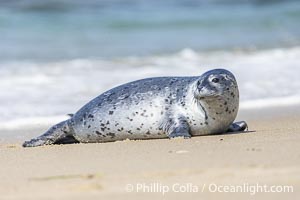
Pacific Harbor Seal Pup About Three Weeks Old, hauled out on a white sand beach along the coast of San Diego. This young seal will be weaned off its mothers milk and care when it is about four to six weeks old, and before that time it must learn how to forage for food on its own, a very difficult time for a young seal.
Species: Pacific harbor seal, Phoca vitulina richardsi
Location: La Jolla, California
Image ID: 39068
Species: Pacific harbor seal, Phoca vitulina richardsi
Location: La Jolla, California
Image ID: 39068
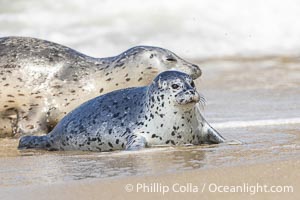
Pacific Harbor Seal Pup About Three Weeks Old, hauled out on a white sand beach along the coast of San Diego. This young seal will be weaned off its mothers milk and care when it is about four to six weeks old, and before that time it must learn how to forage for food on its own, a very difficult time for a young seal.
Species: Pacific harbor seal, Phoca vitulina richardsi
Location: La Jolla, California
Image ID: 39069
Species: Pacific harbor seal, Phoca vitulina richardsi
Location: La Jolla, California
Image ID: 39069
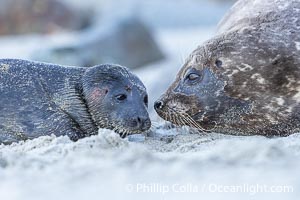
A newborn harbor seal pup, only a few minutes old, is nuzzled by its mother shortly after birth. Blood is still on the tiny pups fur coat. The pair will nuzzle frequently to solidify the bond they must maintain as the pup is nearly helpless. In just four to six weeks the pup will be weaned off its mothers milk and must forage for its own food.
Species: Pacific harbor seal, Phoca vitulina richardsi
Location: La Jolla, California
Image ID: 39073
Species: Pacific harbor seal, Phoca vitulina richardsi
Location: La Jolla, California
Image ID: 39073
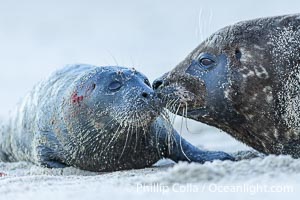
A newborn harbor seal pup in La Jolla, only a few minutes old, is nuzzled by its mother shortly after birth. Blood is still on the tiny pups fur coat. The pair will nuzzle frequently to solidify the bond they must maintain as the pup is nearly helpless. In just four to six weeks the pup will be weaned off its mothers milk and must forage for its own food.
Species: Pacific harbor seal, Phoca vitulina richardsi
Location: La Jolla, California
Image ID: 39077
Species: Pacific harbor seal, Phoca vitulina richardsi
Location: La Jolla, California
Image ID: 39077
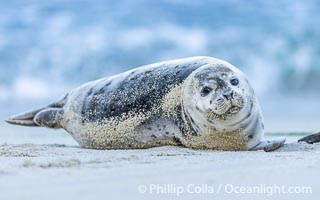
Pacific Harbor Seal Pup About Two Weeks Old, hauled out on a white sand beach along the coast of San Diego. This young seal will be weaned off its mothers milk and care when it is about four to six weeks old, and before that time it must learn how to forage for food on its own, a very difficult time for a young seal.
Species: Pacific harbor seal, Phoca vitulina richardsi
Location: La Jolla, California
Image ID: 39089
Species: Pacific harbor seal, Phoca vitulina richardsi
Location: La Jolla, California
Image ID: 39089
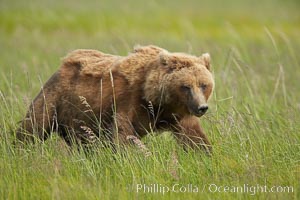
Coastal brown bear in meadow. The tall sedge grasses in this coastal meadow are a food source for brown bears, who may eat 30 lbs of it each day during summer while waiting for their preferred food, salmon, to arrive in the nearby rivers.
Species: Brown bear, Ursus arctos
Location: Lake Clark National Park, Alaska
Image ID: 19138
Species: Brown bear, Ursus arctos
Location: Lake Clark National Park, Alaska
Image ID: 19138
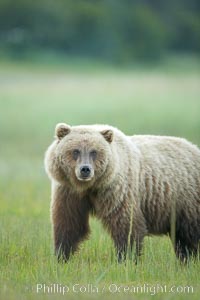
Coastal brown bear in meadow. The tall sedge grasses in this coastal meadow are a food source for brown bears, who may eat 30 lbs of it each day during summer while waiting for their preferred food, salmon, to arrive in the nearby rivers.
Species: Brown bear, Ursus arctos
Location: Lake Clark National Park, Alaska
Image ID: 19155
Species: Brown bear, Ursus arctos
Location: Lake Clark National Park, Alaska
Image ID: 19155
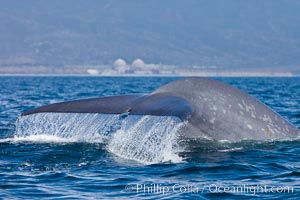
Blue whale and San Onofre Nuclear Power generating station, raising fluke prior to diving for food, fluking up, lifting its tail as it swims in the open ocean foraging for food.
Species: Blue whale, Balaenoptera musculus
Location: Dana Point, California
Image ID: 27337
Species: Blue whale, Balaenoptera musculus
Location: Dana Point, California
Image ID: 27337
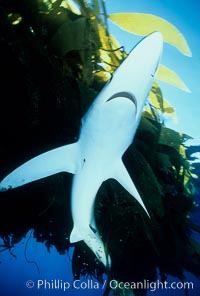
Blue shark searching drift kelp for food, open ocean.
Species: Blue shark, Prionace glauca
Location: San Diego, California
Image ID: 02288
Species: Blue shark, Prionace glauca
Location: San Diego, California
Image ID: 02288
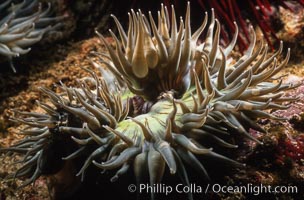
Aggregating anemone opens its arms to passing ocean currents in an attempt to snag passing bits of food or unwary prey.
Species: Aggregating anemone, Anthopleura elegantissima
Location: Laguna Beach, California
Image ID: 00314
Species: Aggregating anemone, Anthopleura elegantissima
Location: Laguna Beach, California
Image ID: 00314
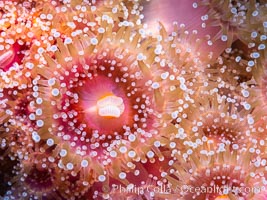
The corallimorph Corynactis californica, similar to both stony corals and anemones, is typified by a wide oral disk and short tentacles that radiate from the mouth. The tentacles grasp food passing by in ocean currents.
Species: Strawberry anemone, Corynactis californica
Location: San Diego, California
Image ID: 37212
Species: Strawberry anemone, Corynactis californica
Location: San Diego, California
Image ID: 37212
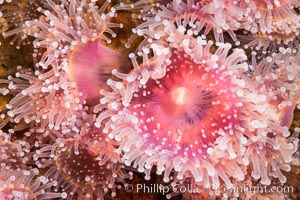
The corallimorph Corynactis californica, similar to both stony corals and anemones, is typified by a wide oral disk and short tentacles that radiate from the mouth. The tentacles grasp food passing by in ocean currents.
Species: Strawberry anemone, Corynactis californica
Location: San Diego, California
Image ID: 37215
Species: Strawberry anemone, Corynactis californica
Location: San Diego, California
Image ID: 37215
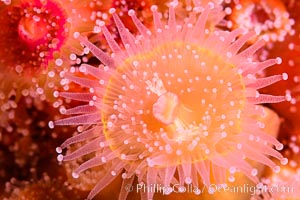
Corynactis anemone polyp, a corallimorph, extends its arms into passing ocean currents to catch food.
Species: Strawberry anemone, Corynactis californica
Location: San Diego, California
Image ID: 33474
Species: Strawberry anemone, Corynactis californica
Location: San Diego, California
Image ID: 33474
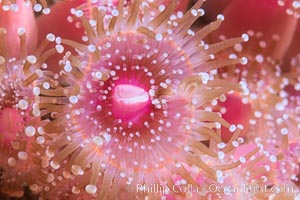
The corallimorph Corynactis californica, similar to both stony corals and anemones, is typified by a wide oral disk and short tentacles that radiate from the mouth. The tentacles grasp food passing by in ocean currents.
Species: Strawberry anemone, Corynactis californica
Location: San Diego, California
Image ID: 37201
Species: Strawberry anemone, Corynactis californica
Location: San Diego, California
Image ID: 37201
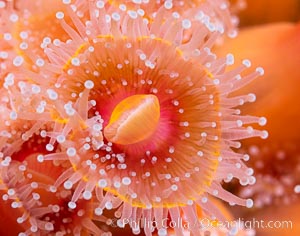
The corallimorph Corynactis californica, similar to both stony corals and anemones, is typified by a wide oral disk and short tentacles that radiate from the mouth. The tentacles grasp food passing by in ocean currents.
Species: Strawberry anemone, Corynactis californica
Location: San Diego, California
Image ID: 37208
Species: Strawberry anemone, Corynactis californica
Location: San Diego, California
Image ID: 37208
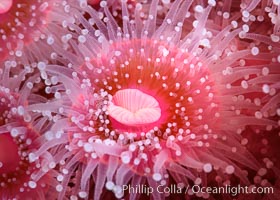
Corynactis anemone polyp, a corallimorph, extends its arms into passing ocean currents to catch food.
Species: Strawberry anemone, Corynactis californica
Location: San Diego, California
Image ID: 33475
Species: Strawberry anemone, Corynactis californica
Location: San Diego, California
Image ID: 33475
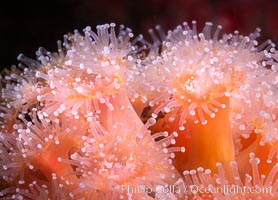
The corallimorph Corynactis californica, similar to both stony corals and anemones, is typified by a wide oral disk and short tentacles that radiate from the mouth. The tentacles grasp food passing by in ocean currents.
Species: Strawberry anemone, Corynactis californica
Location: San Diego, California
Image ID: 37202
Species: Strawberry anemone, Corynactis californica
Location: San Diego, California
Image ID: 37202
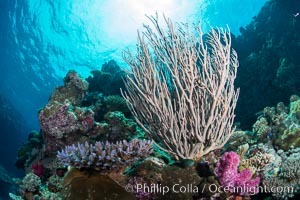
Branching whip coral (Ellisella sp.) captures passing planktonic food in ocean currents, Fiji.
Species: Branching whip coral, Ellisella
Location: Vatu I Ra Passage, Bligh Waters, Viti Levu Island, Fiji
Image ID: 31345
Species: Branching whip coral, Ellisella
Location: Vatu I Ra Passage, Bligh Waters, Viti Levu Island, Fiji
Image ID: 31345
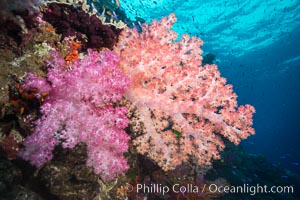
Spectacularly colorful dendronephthya soft corals on South Pacific reef, reaching out into strong ocean currents to capture passing planktonic food, Fiji.
Species: Dendronephthya soft coral, Dendronephthya
Location: Namena Marine Reserve, Namena Island, Fiji
Image ID: 31353
Species: Dendronephthya soft coral, Dendronephthya
Location: Namena Marine Reserve, Namena Island, Fiji
Image ID: 31353
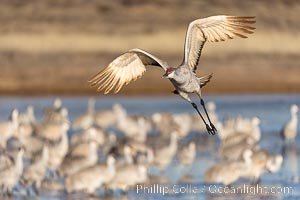
Sandhill Cranes in Flight at Sunrise, Bosque del Apache NWR. At sunrise, sandhill cranes will fly out from the pool in which they spent the night to range over Bosque del Apache NWR in search of food, returning to the pool at sunset.
Species: Sandhill crane, Grus canadensis
Location: Bosque del Apache National Wildlife Refuge, Socorro, New Mexico
Image ID: 38733
Species: Sandhill crane, Grus canadensis
Location: Bosque del Apache National Wildlife Refuge, Socorro, New Mexico
Image ID: 38733
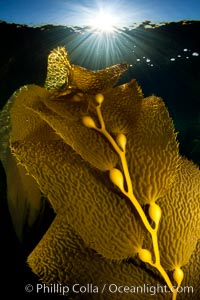
Kelp fronds and pneumatocysts. Pneumatocysts, gas-filled bladders, float the kelp plant off the ocean bottom toward the surface and sunlight, where the leaf-like blades and stipes of the kelp plant grow fastest. Giant kelp can grow up to 2' in a single day given optimal conditions. Epic submarine forests of kelp grow throughout California's Southern Channel Islands.
Species: Giant kelp, Macrocystis pyrifera
Location: San Clemente Island, California
Image ID: 25396
Species: Giant kelp, Macrocystis pyrifera
Location: San Clemente Island, California
Image ID: 25396
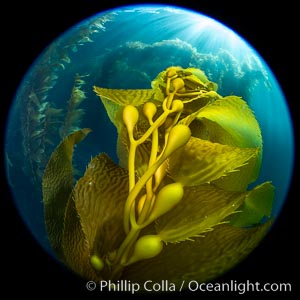
Kelp fronds and pneumatocysts. Pneumatocysts, gas-filled bladders, float the kelp off the ocean bottom toward the surface and sunlight, where the leaf-like blades and stipes of the kelp plant grow fastest. Catalina Island, California.
Species: Giant kelp, Macrocystis pyrifera
Location: Catalina Island, California
Image ID: 37282
Species: Giant kelp, Macrocystis pyrifera
Location: Catalina Island, California
Image ID: 37282
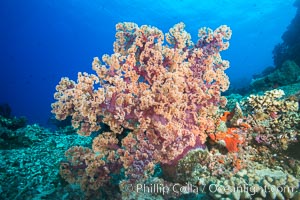
A Large Dendronephthya Soft Coral extends into ocean currents to grasp passing planktonic food, Fiji.
Species: Dendronephthya soft coral, Dendronephthya
Location: Vatu I Ra Passage, Bligh Waters, Viti Levu Island, Fiji
Image ID: 31356
Species: Dendronephthya soft coral, Dendronephthya
Location: Vatu I Ra Passage, Bligh Waters, Viti Levu Island, Fiji
Image ID: 31356
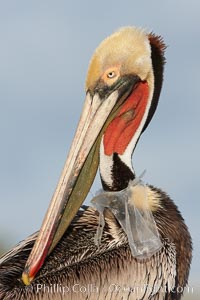
A California brown pelican entangled in a plastic bag which is wrapped around its neck. This unfortunate pelican probably became entangled in the bag by mistaking the floating plastic for food and diving on it, spearing it in such a way that the bag has lodged around the pelican's neck. Plastic bags kill and injure untold numbers of marine animals each year.
Species: Brown Pelican, Pelecanus occidentalis, Pelecanus occidentalis californicus
Location: La Jolla, California
Image ID: 22562
Species: Brown Pelican, Pelecanus occidentalis, Pelecanus occidentalis californicus
Location: La Jolla, California
Image ID: 22562
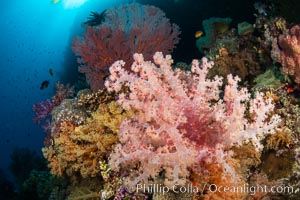
Closeup view of colorful dendronephthya soft corals, reaching out into strong ocean currents to capture passing planktonic food, Fiji.
Species: Dendronephthya soft coral, Dendronephthya
Location: Fiji
Image ID: 34819
Species: Dendronephthya soft coral, Dendronephthya
Location: Fiji
Image ID: 34819
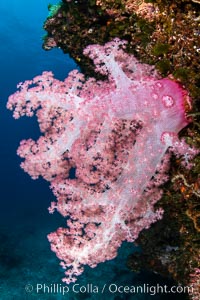
Closeup view of colorful dendronephthya soft corals, reaching out into strong ocean currents to capture passing planktonic food, Fiji.
Species: Dendronephthya soft coral, Dendronephthya
Location: Fiji
Image ID: 34822
Species: Dendronephthya soft coral, Dendronephthya
Location: Fiji
Image ID: 34822
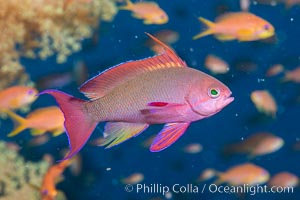
Lyretail Anthias foraging for bits of food passing by in ocean currents, Pseudanthias squamipinnis, Fiji.
Species: Anthias, Pseudanthias
Location: Fiji
Image ID: 34827
Species: Anthias, Pseudanthias
Location: Fiji
Image ID: 34827
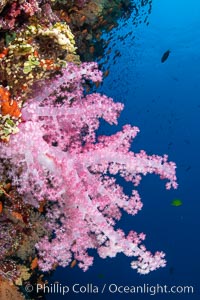
Closeup view of colorful dendronephthya soft corals, reaching out into strong ocean currents to capture passing planktonic food, Fiji.
Species: Dendronephthya soft coral, Dendronephthya
Location: Fiji
Image ID: 34878
Species: Dendronephthya soft coral, Dendronephthya
Location: Fiji
Image ID: 34878
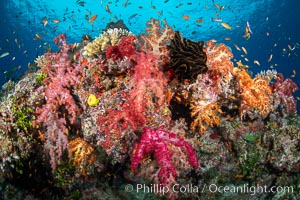
Spectacularly colorful dendronephthya soft corals on South Pacific reef, reaching out into strong ocean currents to capture passing planktonic food, Fiji.
Species: Dendronephthya soft coral, Dendronephthya
Location: Nigali Passage, Gau Island, Lomaiviti Archipelago, Fiji
Image ID: 34880
Species: Dendronephthya soft coral, Dendronephthya
Location: Nigali Passage, Gau Island, Lomaiviti Archipelago, Fiji
Image ID: 34880
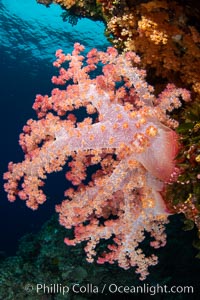
Closeup view of colorful dendronephthya soft corals, reaching out into strong ocean currents to capture passing planktonic food, Fiji.
Species: Dendronephthya soft coral, Dendronephthya
Location: Vatu I Ra Passage, Bligh Waters, Viti Levu Island, Fiji
Image ID: 34881
Species: Dendronephthya soft coral, Dendronephthya
Location: Vatu I Ra Passage, Bligh Waters, Viti Levu Island, Fiji
Image ID: 34881